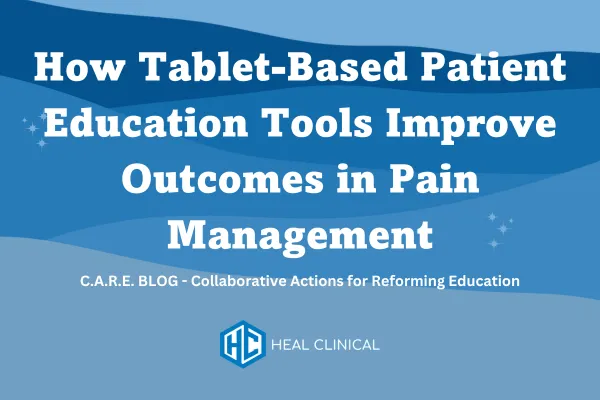
How Tablet-Based Patient Education Tools Improve Outcomes in Pain Management
How Tablet-Based Patient Education Tools Improve Outcomes in Pain Management
Reduce Risk, Not Revenue: How Pain Clinics Can Protect Themselves from Opioid-Related Liability
Pain clinics operate in one of the highest-liability areas of medicine. Prescribing opioids is both necessary and risky. Clinics face legal exposure, patient misunderstanding, and potential non-compliance, all of which can have devastating consequences for both patients and providers.
Too often, clinics default to verbal conversations or printed pamphlets to educate patients on opioid safety—but these methods fall short. Patients forget, misunderstand, or misplace this information, leaving doctors vulnerable. Worse, inconsistent documentation can cost clinics reimbursement or expose them to litigation.
The Solution: HEAL-O Tablet-Based Patient Education
HEAL-O is a tablet-based opioid education program for patients that delivers consistent, interactive education in the clinic—typically while patients are waiting in the lobby. This ensures they receive essential safety information before entering the exam room. It’s fast, trackable, and billable.
Patients engage with HEAL-O for about 6–8 minutes and complete an Adverse Event Plan (AEP) that captures their understanding of opioid safety, including:
✔ What opioids are and how to use them safely
✔ What Naloxone (Narcan) is, when to use it, and how to access it
✔ Who in their household should know about the prescription
✔ Whether they’ve had a conversation about safe storage and disposal
The AEP is a structured output from the HEAL-O session that documents patient comprehension and behavioral readiness. Patients are asked five core questions—focused on safety, intent, communication, and emergency readiness. If the patient answers all five questions correctly after three sessions, the system records an “Active AEP.” This becomes part of the medical record and proof of opioid safety education.
It also identifies red flags—such as patients who don’t know what Naloxone is, or who haven’t discussed their prescription with family—alerting providers to intervene.
Workflow-Friendly and Scalable
HEAL-O integrates easily into existing workflows by running on in-clinic tablets (like Lenovo or iPad), requiring no added staff time. Since it operates while the patient waits, it enhances—not delays—the clinical encounter. When the patient finishes, the provider gets an educational report plus a billing summary.
This ease of use means providers can reduce opioid risk in pain clinics without disrupting their day or adding burdens to already-overworked staff.
CPT Reimbursement: Education That Pays
HEAL-O supports reimbursable patient education programs under a variety of CPT codes for opioid counseling reimbursement, including:
📌 H0049 – Alcohol and/or drug screening (Medicaid)
📌 G0396 – Alcohol and/or substance (other than tobacco) structured assessment and brief intervention (Medicare)
📌 99401 – Preventive medicine counseling (Commercial Plans)
These CPT codes allow clinics to get reimbursed for doing the right thing—educating patients. And since HEAL-O is built around these codes, providers don’t need to manually map documentation or guess at payer policy; it’s built in.
Risk-Free Implementation with Real ROI
Federal lawsuits, medical board sanctions, and patient harm all point to a single truth: doing nothing is the greatest risk. Yet many clinics delay implementing education programs due to perceived costs or staff limitations.
HEAL-O addresses both. It’s risk-free to implement, requires no minimal capital, and only costs the clinic when it’s reimbursed. The digital AEP and education summary reduce legal liability, while the opioid safety tools for doctors and providers help patients make informed decisions.
Tablet-based tools like HEAL-O are more than just educational—they are strategic. They reduce risk, capture revenue, and improve patient outcomes. With reimbursement tied to education, and education tied to protection, HEAL-O offers a practical, compliant way forward for pain management practices.
💡 Clinics using HEAL-O are not just prescribing medication—they are building a safer, smarter, and more sustainable model of care.
